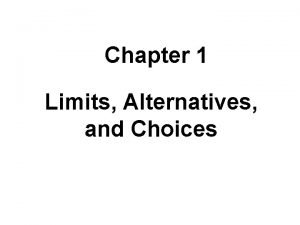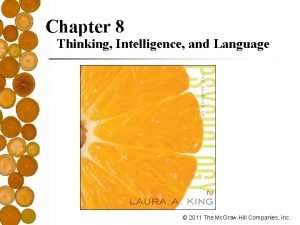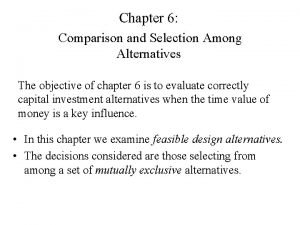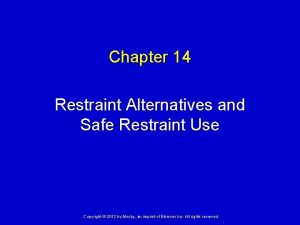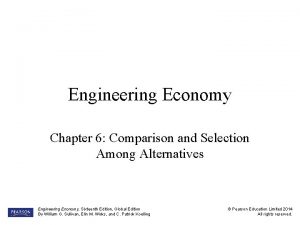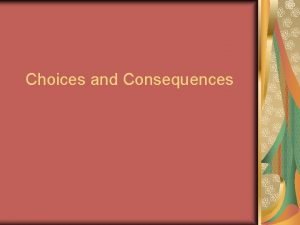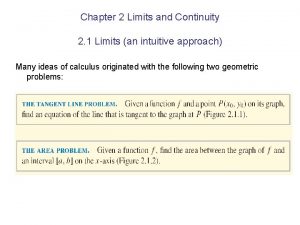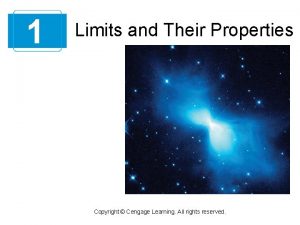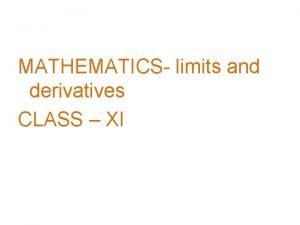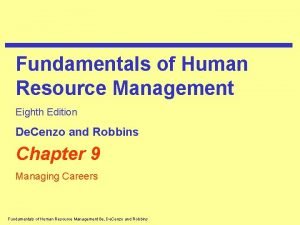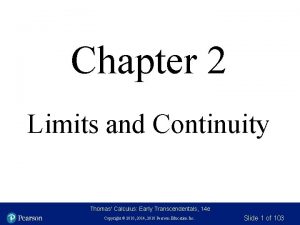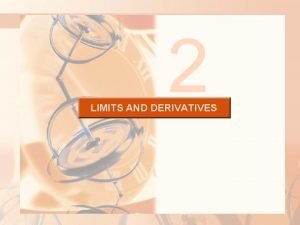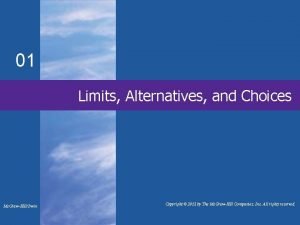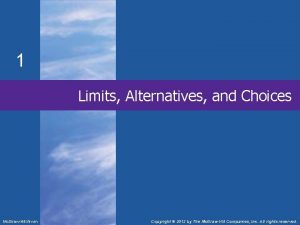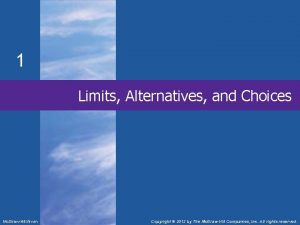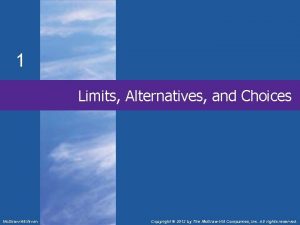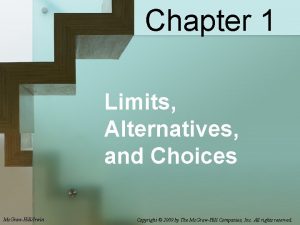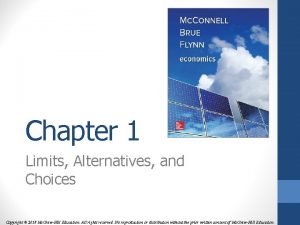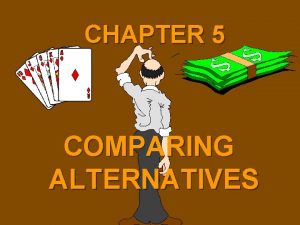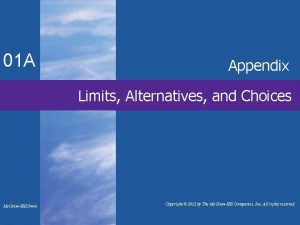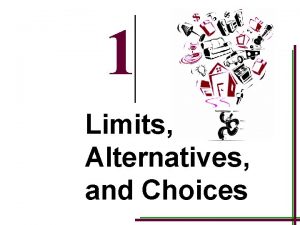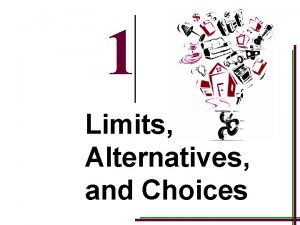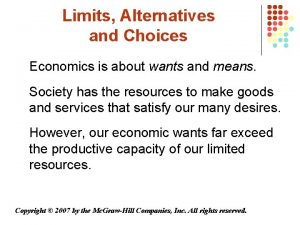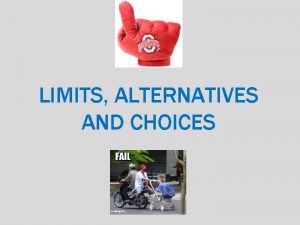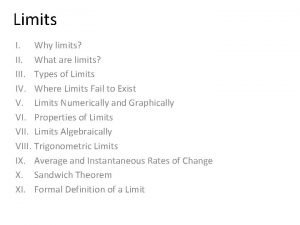01 Limits Alternatives and Choices Mc GrawHillIrwin Copyright





























- Slides: 29

01 Limits, Alternatives, and Choices Mc. Graw-Hill/Irwin Copyright © 2012 by The Mc. Graw-Hill Companies, Inc. All rights reserved.

Introduction • LO 1 Economics defined: • Economic wants exceed productive capacity. • A social science concerned with making optimal choices under conditions of scarcity. • Episode 2: Scarcity and Choice • Econ. movies 1: Star Wars (Scarcity, Choices and Exchange) 1 -2

The Economic Perspective • • Thinking like an economist Key features: • • LO 1 Scarcity and choice Purposeful behavior Marginal analysis https: //www. youtube. com/watch? v=yw. HW 1 -x. P 0 PQ 1 -3

Scarcity and Choice • • • LO 1 Resources are scarce Choices must be made Opportunity cost • There’s no free lunch • Opportunity Cost https: //www. youtube. com/watch? v=Nw. OYLV-L 7 pc 1 -4

Purposeful Behavior • • LO 1 Rational self-interest Individuals and utility Firms and profit Desired outcomes 1 -5

Marginal Analysis • • • LO 1 Marginal benefit Marginal cost Marginal means “extra” Comparison between marginal benefit and marginal cost Econ. movies 2: Monty Python and the Holy Grail (Marginal Analysis) Marginal analysis https: //www. youtube. com/watch? v=yw. HW 1 -x. P 0 PQ 1 -6

Theories, Principles, and Models • The scientific method: Observe Formulate a hypothesis Test the hypothesis Accept, reject, or modify the hypothesis Continue to test the hypothesis, if necessary • Economic principles • Generalizations • Other-things-equal assumption • Graphical expression LO 2 1 -7

Microeconomics and Macroeconomics • Microeconomics • • Macroeconomics • LO 3 Decision making by individual units Aggregate 1 -8

Positive and Normative Economics • Positive economics • • Normative economics • LO 3 Deals with economic facts A subjective perspective of the economy 1 -9

Individual’s Economizing Problem • • • Limited income Unlimited wants A budget line • • LO 4 Attainable and unattainable options Tradeoffs and opportunity costs Make the best choice possible Change in income 1 -10

Individual’s Economizing Problem DVDs Books $20 $10 6 5 4 3 2 1 0 0 2 4 6 8 10 12 12 10 Quantity of DVDs $120 Budget Income = $120 Pdvd = $20 8 =6 Unattainable 6 Income = $120 4 2 0 Pb = $10 Attainable 2 4 6 8 10 12 Quantity of Paperback Books LO 4 = 12 14 1 -11

Society’s Economizing Problem • Scarce resources • • LO 4 Land Labor Capital Entrepreneurial Ability 1 -12

Society’s Economizing Problem • Entrepreneurial ability • • LO 4 Takes initiative Makes decisions Innovates Takes risk 1 -13

Production Possibilities Model • • Illustrates production choices Assumptions: • • • LO 5 Full employment Fixed resources Fixed technology Two goods Production Possibilities Curve- Econ 1. 1 Econ. movies 1: Monsters Inc. (Production Possibilities Curve) 1 -14

Production Possibilities Table Production Alternatives Type of Product Pizzas A B C D E 0 1 2 3 4 10 9 7 4 0 (in hundred thousands) Industrial Robots (in thousands) Plot the Points to Create the Graph… LO 5 1 -15

Industrial Robots Production Possibilities Curve 14 13 12 11 10 9 8 7 6 5 4 3 2 1 The law of increasing opportunity costs makes the PPC concave. A B Unattainable C D U Attainable E 0 1 2 3 4 5 6 7 8 9 Pizzas LO 5 1 -16

Economic Rationale • The law of increasing opportunity costs is driven by the fact that economic resources are not completely adaptable to alternative uses. Many resources are better at producing one type of good than at producing others. Consider land. Some land is highly suited to growing the ingredients necessary for pizza production. But as pizza production expands, society has to start using land that is less bountiful for farming. Other land is rich in mineral deposits and therefore well-suited to producing the materials needed to make industrial robots. That land will be the first land devoted to the production of industrial robots. But as society steps up the production of robots, it must use land that is less and less suited to making their components

Marginal Benefit & Marginal Cost Optimal Allocation MC 15 c MB = MC e 10 5 0 LO 5 a b d MB 1 2 Quantity of Pizza 3 1 -18

A Growing Economy • Economic Growth • • LO 6 More resources Improved resource quality Technological advances Last class. Episode 2: Scarcity and Choice 1 -19

A Growing Economy Production Alternatives Type of Product Pizzas A' B' C' D' E' 0 2 4 6 8 14 12 9 5 0 (in hundred thousands) Industrial Robots (in thousands) LO 6 1 -20

Industrial Robots A Growing Economy A’ 14 13 12 11 10 9 8 7 6 5 4 3 2 1 B’ Unattainable A B Economic Growth C’ C D’ D Now Attainable E’ E 0 1 2 3 4 5 6 7 8 9 Pizzas LO 6 1 -21

Present Choices, Future Possibilities Future Curve Current Curve P Goods for the Presentville LO 6 Goods for the Future Compare Two Hypothetical Economies Future Curve F Current Curve Goods for the Present Futureville 1 -22

International Trade • • LO 6 Specialization Increased production possibilities 1 -23

Pitfalls to Sound Economic Reasoning • • • Biases Loaded terminology Fallacy of composition Post hoc fallacy Correlation not causation 1 -24

Biases • Most people bring a bundle of biases and preconceptions to the field of economics. For example, some might think that corporate profits are excessive or that lending money is always superior to borrowing money. • Others might believe that government is necessarily less efficient than businesses or that more government regulation is always better than less. Biases cloud thinking and interfere with objective analysis. All of us must be willing to shed biases and preconceptions that are not supported by facts.

Loaded Terminology • The economic terminology used in newspapers and broadcast media is sometimes emotionally biased, or loaded. The writer or spokesperson may have a cause to promote or an ax to grind and may slant comments accordingly. High profits may be labeled "obscene, " low wages may be called "exploitative" or self-interested behavior may be "greed. " Government workers may be referred to as "mindless bureaucrats" and those favoring stronger government regulations may be called "socialists. " To objectively analyze economic issues, you must be prepared to reject or discount such terminology.

Fallacy of Composition • What is true for one individual or part of a whole is necessarily true for a group of individuals or the whole. • A statement that is valid for an individual or part is not necessarily valid for the larger group or whole. • Money example

Post Hoc Fallacy • Event A precedes event B, A is the cause of B. • This kind of faulty reasoning is known as the post hoc, ergo propter hoc, or "after this, therefore because of this, " fallacy. • Noneconomic example: • A professional football team hires a new coach and the team's record improves. Is the new coach the cause? Maybe. Perhaps the presence of more experienced and talented players or an easier schedule is the true cause. The rooster crows before dawn but does not cause the sunrise.

Correlation but Not Causation • For example, we may find that when variable X increases, Y also increases. But this correlation does not necessarilymean that there is causation-v-that increases in X cause increases in Y The relationship could be purely coincidental or dependent on some other factor, Z, not included in the analysis.
 Chapter 1 limits alternatives and choices
Chapter 1 limits alternatives and choices Ap psychology thinking language and intelligence
Ap psychology thinking language and intelligence Evaluating alternatives and making choices among them
Evaluating alternatives and making choices among them Evaluating alternatives and making choices among them
Evaluating alternatives and making choices among them Limit involving infinity
Limit involving infinity Histogram polygon graph
Histogram polygon graph Family of orientation
Family of orientation Marriages and families changes choices and constraints
Marriages and families changes choices and constraints Comparison and selection among alternatives
Comparison and selection among alternatives Assessment and treatment alternatives
Assessment and treatment alternatives Restraint alternatives are
Restraint alternatives are Restraint alternatives are
Restraint alternatives are Your local foundry is adding a new furnace
Your local foundry is adding a new furnace Limit and continuity solved problems
Limit and continuity solved problems Limits fits and tolerances
Limits fits and tolerances Ionizing radiation examples
Ionizing radiation examples Choices and consequences examples
Choices and consequences examples Calculus chapter 2 limits and continuity answers
Calculus chapter 2 limits and continuity answers Limits fits and tolerances
Limits fits and tolerances Chapter 1 limits and their properties
Chapter 1 limits and their properties Limits and their properties
Limits and their properties Fundamental deviation
Fundamental deviation Summary sentence starters
Summary sentence starters Ncert limits and derivatives pdf
Ncert limits and derivatives pdf Career choices and preferences in hrm
Career choices and preferences in hrm Allen steble
Allen steble Thomas calculus limits and continuity
Thomas calculus limits and continuity Plastic limit formula
Plastic limit formula Limits and derivatives
Limits and derivatives Lesson 2: understanding limits graphically and numerically
Lesson 2: understanding limits graphically and numerically
